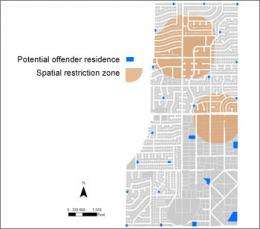A geographical look at sex offender policies

A March 2011 news posting from Kingman, Ariz., reports that a convicted sex offender broke into a home, kidnapped an eight-year-old girl, and molested her outside. Such an unfortunate event and others like it have spawned a flurry of sex offender laws at the federal, state and local levels in recent years designed to prevent this type of incident. Common strategies range from sex offender registries and other public notification to spatial restriction zones.
Restriction zones are meant to prohibit offenders from residing either too close to sensitive facilities, such as schools and playgrounds, or too close to other offenders. The goal is to minimize community vulnerability as well as limit potential contact with children and other at-risk groups.
These legislative efforts are not without controversy, however, and opponents of these laws argue that restrictions produce unintended or collateral consequences for offenders that range from public shaming to the lack of affordable housing options. In this respect, spatial restriction zones are the subject of much attention because they are believed to reduce housing options for offenders and produce sex offender clusters in the few areas where offenders are permitted to reside.
Geographical analysis can provide useful decision support tools to help craft and evaluate sex offender policies, argue Alan Murray, Serge Rey, Luc Anselin and Elizabeth Mack of ASU’s School of Geographical Sciences and Urban Planning and Marie Griffin of ASU’s School of Criminology and Criminal Justice, along with co-investigator Tony Grubesic of Drexel University’s College of Information Science and Technology.
A recent article in Cityscape is the culmination of research on this topic funded by a two-year $250,000 grant from the National Science Foundation that produced some 14 articles. The paper provides an overview of how sex offender residency laws interact with local geography and city forms, creating both intended and unintended outcomes. The key lesson to be gleaned from this body of research is the highly contextual nature of restriction zone impacts and the utility of geographic analysis in assessing laws before they are enacted.
Professor Murray notes that “our research found that about 65 percent of registered offenders changed residences over a two-and-a-half year study period.” He adds that “what is particularly curious about these moves is that approximately one-third of them were into spatial restriction zones, or rather areas that are deemed off limits to convicted sex offenders. Some might consider this predatory.”
More information: www.lvrj.com/news/sex-offender … izona-118685479.html
Provided by Arizona State University















